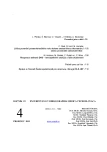Reoperation of the DHS failure – retrospective analysis and our experience
Authors:
Maroš Hrubina 1,2; Miroslav Skoták 1; Zdeněk Rybář ml. 1; Pavel Míka 1
Authors‘ workplace:
Department of Orthopaedics, Hospital Pelhrimov
1; Ortopedické oddělení Nemocnice Pelhřimov
1; Faculty of Biomedical Engineering, Department of Medicine and Humanities Kladno, Czech Technical University in Prague
2; Fakulta biomedicínského inženýrství - katedra lékařských a humanitných oborů Kladno, ČVUT v Praze
2
Published in:
Úraz chir. 19., 2011, č.4
Overview
The aim of the study:
To present the results of proximal femoral fracutres treated by DHS aiming to failed and reoperated osteosyntheses.
Material and methods:
Between 1997 and 2008, 404 osteosyntheses DHS were performed as treatment of proximal femoral fractures in 377 patients averagely 82,2 years old aged (21-101). Twenty seven patients were operated for fracture of both sides. Osteosynthesis was always performed by 135° dynamic hip screw (Medin, Czech Republic). Fifteen times for femoral neck fracture, 389-times for trochanteric fracture. The group of patients was evaluated in the end of 2010 aiming at incidence and technique of failed DHS reoperations. X-ray examination of the femur was performed before patient´s discharge, in 6th week after operation and then in 3rd, 6th and 12th month after the operation.
Results:
Seventeen failed and reoperated DHS (4,2 %) within 16 patients were reported. During the operation we performed: once – only the metal extraction, once - metal extraction with using of bone cement spacer, twice reoperation with 6-hole plate, twice reoperation with PFN, three times reoperation using cervicocapital endoprosthesis and eight times was reoperation performed by conversion to total hip arthroplasty. Due to infection two, out of 404 cases (0,5 %), DHS were reoperated. Out of 15 ostesyntheses of femoral neck fractures 3 (20 %) were reoperated. Out of 389 DHS applied to trochanteric fractures 14 (3,6 %) were reoperated. Mortality rate up to one year after the primary operation was 48%, up to one year after the reoperation was 19 %.
Conclusion:
Authors consider DHS method proper to treat stable pertrochanteric fractures and femoral neck fractures of younger patients. Reoperation (except femoral neck fractures) are rare, partialy they are the result of technical mistake during primary osteosynthesis.
Key words:
hip fracture, dynamic hip screw, failure rate, reoperation.
Sources
1. BARTONÍČEK, J., DOUŠA, P., SKÁLA-ROSENBAUM, J., KOŠŤÁL, R. Trochanterické zlomeniny – souborný referát. Úraz chir. 2002, 10, 13–24.
2. BARTON, T. M., GLEESON, R., TOPLISS, C. et al. A comparison of the long gama nail with the sliding hip screw for the treatment of AO/OTA 31-A2 fractures of the proximal part of the femur. J Bone Joint Surg Am. 2010, 92, 792–798.
3. BHATTI, A., ABBASI, A. Intra pelvic total migration of sliding screw in intetrochanteric fracture. J Coll Physicians Surg Pak. 2007, 17, 371–373.
4. DŽUPA, V., BARTONÍČEK, J., SKÁLA-ROSENBAUM, J., PŘÍKAZSKÝ, V. Úmrtí pacientů se zlomeninou proximálního femuru v průběhu prvního roku po úrazu. Acta Chir Orthop Traumatol Czech. 2002, 69, 39–44.
5. GUŘAN, M., ČAMBOR, S., LISÝ, M. et al. Zlomeniny krčku stehenní kosti u dětí a adolescentů. Úraz chir. 2009, 17, 19–24.
6. GUŘAN, M., ČAMBOR, S., LISÝ, M. et al. Riziko aseptické nekrózy hlavice stehenní kosti po zlomenině krčku stehenní kosti – experimentální studie. Úraz chir. 2009, 17, 25–29.
7. HRUBINA, M., SKOTÁK, M., BĚHOUNEK, J. Komplikace operační léčby zlomenin proximálního femuru metodou DHS. Acta Chir orthop Traumatol Czech. 2010, 77, 395–401.
8. JAHODA, D., NYČ, O., POKORNÝ, D., LANDOR, I., SOSNA, A. Antibiotika v prevenci infekčních komplikací u operací kloubních náhrad. Acta Chir orthop. Traumatol Czech. 2006, 73,108–113.
9. KNOBE, M., MÜNKER, R., SELLEI, R. M. et al. Unstable pertrochanteric femur fractures. Failure rate, lag screw sliding and outcome with extra - and intramedullary devices (PCCP, DHS and PFN). Z Orthop Unfal. 2009, 147, 306–313.
10. KNOBE, M., MÜNKER, R., SCHMIDT-ROHLFING, B. et al. Surgical outcome in pertrochanteric femur fracture: the impact of osteoporosis. Comparison between DHS and percutaneous compression plate. Z Orthop Unfall. 2008, 146, 44–51.
11. KOPP, L., EDELMAN, K., OBRUBA, P., PROCHÁZKA, B., BLŠŤÁKOVÁ, K., DŽUPA, V. Rizikové faktory úmrtí seniorů operovaných pro zlomeninu proximálního femuru. Acta Chir orthop Traumatol Czech. 2009, 76, 41–46.
12. KOUDELA, K., KASAL, E., MATĚJKA, J., VYSKOČIL, V. Geriatrická traumatologie - vize nebo skutečnost?. Acta Chir orthop Traumatol Czech. 2009, 76, 338–343.
13. MAJERNÍČEK, M., DUNGL, P., KOLMAN, J., MALKUS, T., VACULÍK, J. Osteosyntéza intrakapsulárních zlomenin krčku stehenní kosti metodou DHS. Acta Chir orthop Traumatol Czech. 2009, 76, 319–325.
14. MAJERNÍČEK, M., DUNGL, P., VACULÍK, J., MALKUS, T. Léčba zlomenin krčku stehenní kosti. Ortopedie. 2009, 6, 292–298.
15. MALKUS, T., VACULÍK, J., DUNGL, P., MAJERNÍČEK, M. Problematika pertrochanterických zlomenin. Ortopedie. 2009, 6, 274–282.
16. SKLÁDAL, M., PINK, M., LISÝ, M., NOVOTNÝ, L. Ošetření trochanterických zlomenin PC.C.P. dlahou. Acta Chir orthop Traumatol Czech. 2009, 76, 202–207.
17. SKOTÁK, M., BĚHOUNEK, J., KRUMPL, O. Řešení pertrochanterických zlomenin proximálního femuru 130 st. dlahou – dlouhodobé výsledky. Acta Chir orthop Traumatol Czech. 1999, 66, 336–341.
18. STERN, R., LÜBBEKE, A., SUVA, D. al. Prospective randomised study comparing screw versus helical blade in the treatment of low-energy trochanteric fractures. Int Orthop. 2011, 10.
19. ZATLOUKAL A., MRÁZEK, T. Fraktury proximálního femuru – mají pacienti časně operovaní nižší mortalitu než operovaní odloženě? Úraz chir. 2009, 17, 30–33.
Labels
Surgery Traumatology Trauma surgeryArticle was published in
Trauma Surgery

2011 Issue 4
- Metamizole vs. Tramadol in Postoperative Analgesia
- Metamizole at a Glance and in Practice – Effective Non-Opioid Analgesic for All Ages
- The Importance of Hydration in Wound Healing
- Obstacle Called Vasospasm: Which Solution Is Most Effective in Microsurgery and How to Pharmacologically Assist It?
- Possibilities of Using Metamizole in the Treatment of Acute Primary Headaches
Most read in this issue
- Treatment of posterolateral corner injuries with anatomical reconstruction and/or high tibial osteotomy
- Reoperation of the DHS failure – retrospective analysis and our experience
- Liver injury in children
